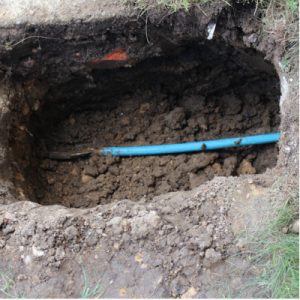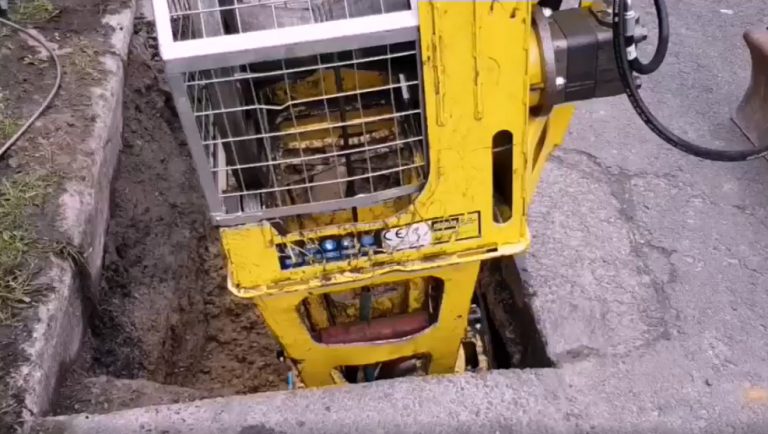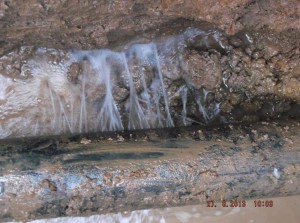In the UK, pipe replacement falls to utility companies who are regulated by Ofwat (for water) and Ofgem (for gas). Regulators are responsible for setting limits on pricing to consumers for supply, and regulate the way the utility companies manage the infrastructure, ensuring adequate investment is made during specified periods to maintain and improve supplies.  The challenge Renewing infrastructure is a key part of the utilities’ responsibilities, which includes renewing service pipes. In the UK, it is estimated there are over 340,000kms of mains water pipes, and for every 10 metres on average there is a service pipe connecting a home or business to the mains supply. Over 3,000 million litres of water is leaked from the infrastructure each day. A proportion of service pipes need to be replaced each year to manage supplies, reduce leakage, and maintain water quality. In the United States, water quality has become a particular issue in recent years following the Flint lead contamination saga. There are an estimated 7 million lead pipes connecting US homes to the mains water supply. Assuming the average length of service pipe is 15metres, that means there is 105million metres of lead pipe (65k miles) that needs replacing at an estimated cost of over $1 trillion. In the gas sector, particularly in the UK, gas service pipes were originally made of galvanised steel. These are, however, prone to corrosion and eventually will fail causing dangerous gas leakage. Ofgem in the UK has made replacement of all galvanised steel gas service pipes mandatory. Gas Distribution Network companies, such as Cadent Gas, have replacement programmes planned for years. In the UK alone, there are estimated to be over 275,000 kms of gas mains, which is being replaced at approximately 4,500 kms per year, and the network services over 23 million gas residential and business customers. Why does it need addressing? Many older properties in the UK and North America (built before the 1970’s) had lead pipes supplying water to each property. While many of these have been replaced over the years, a significant number still remain. Lead has been proven harmful to human health, and children are especially susceptible. Water companies use phosphate dosing at treatment works to coat the inside of the pipe to prevent leaching, but phosphate is a finite resource and unsustainable. Therefore, to protect the public, and improve water quality, water companies have been and continue to look at pipe replacement strategies. In respect of galvanised iron gas service pipes, degradation over time will ultimately increase the risk of pipes failing and gas leaks occurring. If left unchecked? Utility companies worldwide have to plan long into the future to continuously replace ageing infrastructure. Left unmanaged, the problems caused by ageing pipes will accumulate. The need to address the resulting issues will become more urgent, and to tackle the problem on a wider scale with more urgency will require significantly more investment. This investment will be funded through higher consumer bills. Solution Regulators enforce controls and pressure the utilities companies to use, for example, innovation, to maintain and replace infrastructure faster and more safely, with less disruption, and without significant increases in consumer’s bills. Pipe pulling technology offers utility companies ‘innovation’, as mandated by the Regulator. It also offers reduced cost compared to other methods such as open cut excavation.
The challenge Renewing infrastructure is a key part of the utilities’ responsibilities, which includes renewing service pipes. In the UK, it is estimated there are over 340,000kms of mains water pipes, and for every 10 metres on average there is a service pipe connecting a home or business to the mains supply. Over 3,000 million litres of water is leaked from the infrastructure each day. A proportion of service pipes need to be replaced each year to manage supplies, reduce leakage, and maintain water quality. In the United States, water quality has become a particular issue in recent years following the Flint lead contamination saga. There are an estimated 7 million lead pipes connecting US homes to the mains water supply. Assuming the average length of service pipe is 15metres, that means there is 105million metres of lead pipe (65k miles) that needs replacing at an estimated cost of over $1 trillion. In the gas sector, particularly in the UK, gas service pipes were originally made of galvanised steel. These are, however, prone to corrosion and eventually will fail causing dangerous gas leakage. Ofgem in the UK has made replacement of all galvanised steel gas service pipes mandatory. Gas Distribution Network companies, such as Cadent Gas, have replacement programmes planned for years. In the UK alone, there are estimated to be over 275,000 kms of gas mains, which is being replaced at approximately 4,500 kms per year, and the network services over 23 million gas residential and business customers. Why does it need addressing? Many older properties in the UK and North America (built before the 1970’s) had lead pipes supplying water to each property. While many of these have been replaced over the years, a significant number still remain. Lead has been proven harmful to human health, and children are especially susceptible. Water companies use phosphate dosing at treatment works to coat the inside of the pipe to prevent leaching, but phosphate is a finite resource and unsustainable. Therefore, to protect the public, and improve water quality, water companies have been and continue to look at pipe replacement strategies. In respect of galvanised iron gas service pipes, degradation over time will ultimately increase the risk of pipes failing and gas leaks occurring. If left unchecked? Utility companies worldwide have to plan long into the future to continuously replace ageing infrastructure. Left unmanaged, the problems caused by ageing pipes will accumulate. The need to address the resulting issues will become more urgent, and to tackle the problem on a wider scale with more urgency will require significantly more investment. This investment will be funded through higher consumer bills. Solution Regulators enforce controls and pressure the utilities companies to use, for example, innovation, to maintain and replace infrastructure faster and more safely, with less disruption, and without significant increases in consumer’s bills. Pipe pulling technology offers utility companies ‘innovation’, as mandated by the Regulator. It also offers reduced cost compared to other methods such as open cut excavation.
 The challenge Renewing infrastructure is a key part of the utilities’ responsibilities, which includes renewing service pipes. In the UK, it is estimated there are over 340,000kms of mains water pipes, and for every 10 metres on average there is a service pipe connecting a home or business to the mains supply. Over 3,000 million litres of water is leaked from the infrastructure each day. A proportion of service pipes need to be replaced each year to manage supplies, reduce leakage, and maintain water quality. In the United States, water quality has become a particular issue in recent years following the Flint lead contamination saga. There are an estimated 7 million lead pipes connecting US homes to the mains water supply. Assuming the average length of service pipe is 15metres, that means there is 105million metres of lead pipe (65k miles) that needs replacing at an estimated cost of over $1 trillion. In the gas sector, particularly in the UK, gas service pipes were originally made of galvanised steel. These are, however, prone to corrosion and eventually will fail causing dangerous gas leakage. Ofgem in the UK has made replacement of all galvanised steel gas service pipes mandatory. Gas Distribution Network companies, such as Cadent Gas, have replacement programmes planned for years. In the UK alone, there are estimated to be over 275,000 kms of gas mains, which is being replaced at approximately 4,500 kms per year, and the network services over 23 million gas residential and business customers. Why does it need addressing? Many older properties in the UK and North America (built before the 1970’s) had lead pipes supplying water to each property. While many of these have been replaced over the years, a significant number still remain. Lead has been proven harmful to human health, and children are especially susceptible. Water companies use phosphate dosing at treatment works to coat the inside of the pipe to prevent leaching, but phosphate is a finite resource and unsustainable. Therefore, to protect the public, and improve water quality, water companies have been and continue to look at pipe replacement strategies. In respect of galvanised iron gas service pipes, degradation over time will ultimately increase the risk of pipes failing and gas leaks occurring. If left unchecked? Utility companies worldwide have to plan long into the future to continuously replace ageing infrastructure. Left unmanaged, the problems caused by ageing pipes will accumulate. The need to address the resulting issues will become more urgent, and to tackle the problem on a wider scale with more urgency will require significantly more investment. This investment will be funded through higher consumer bills. Solution Regulators enforce controls and pressure the utilities companies to use, for example, innovation, to maintain and replace infrastructure faster and more safely, with less disruption, and without significant increases in consumer’s bills. Pipe pulling technology offers utility companies ‘innovation’, as mandated by the Regulator. It also offers reduced cost compared to other methods such as open cut excavation.
The challenge Renewing infrastructure is a key part of the utilities’ responsibilities, which includes renewing service pipes. In the UK, it is estimated there are over 340,000kms of mains water pipes, and for every 10 metres on average there is a service pipe connecting a home or business to the mains supply. Over 3,000 million litres of water is leaked from the infrastructure each day. A proportion of service pipes need to be replaced each year to manage supplies, reduce leakage, and maintain water quality. In the United States, water quality has become a particular issue in recent years following the Flint lead contamination saga. There are an estimated 7 million lead pipes connecting US homes to the mains water supply. Assuming the average length of service pipe is 15metres, that means there is 105million metres of lead pipe (65k miles) that needs replacing at an estimated cost of over $1 trillion. In the gas sector, particularly in the UK, gas service pipes were originally made of galvanised steel. These are, however, prone to corrosion and eventually will fail causing dangerous gas leakage. Ofgem in the UK has made replacement of all galvanised steel gas service pipes mandatory. Gas Distribution Network companies, such as Cadent Gas, have replacement programmes planned for years. In the UK alone, there are estimated to be over 275,000 kms of gas mains, which is being replaced at approximately 4,500 kms per year, and the network services over 23 million gas residential and business customers. Why does it need addressing? Many older properties in the UK and North America (built before the 1970’s) had lead pipes supplying water to each property. While many of these have been replaced over the years, a significant number still remain. Lead has been proven harmful to human health, and children are especially susceptible. Water companies use phosphate dosing at treatment works to coat the inside of the pipe to prevent leaching, but phosphate is a finite resource and unsustainable. Therefore, to protect the public, and improve water quality, water companies have been and continue to look at pipe replacement strategies. In respect of galvanised iron gas service pipes, degradation over time will ultimately increase the risk of pipes failing and gas leaks occurring. If left unchecked? Utility companies worldwide have to plan long into the future to continuously replace ageing infrastructure. Left unmanaged, the problems caused by ageing pipes will accumulate. The need to address the resulting issues will become more urgent, and to tackle the problem on a wider scale with more urgency will require significantly more investment. This investment will be funded through higher consumer bills. Solution Regulators enforce controls and pressure the utilities companies to use, for example, innovation, to maintain and replace infrastructure faster and more safely, with less disruption, and without significant increases in consumer’s bills. Pipe pulling technology offers utility companies ‘innovation’, as mandated by the Regulator. It also offers reduced cost compared to other methods such as open cut excavation.Like this post and want more?
Be one of the first to download our new guide Download our new ground-breaking Ten challenges facing pipe replacement contractors – and how to tackle them more effectively now here.Sign up to receive our FREE essential guide to the ‘Ten challenges facing pipe replacement contractors – and how to tackle them. Click on the ‘Download Guide’ button here



